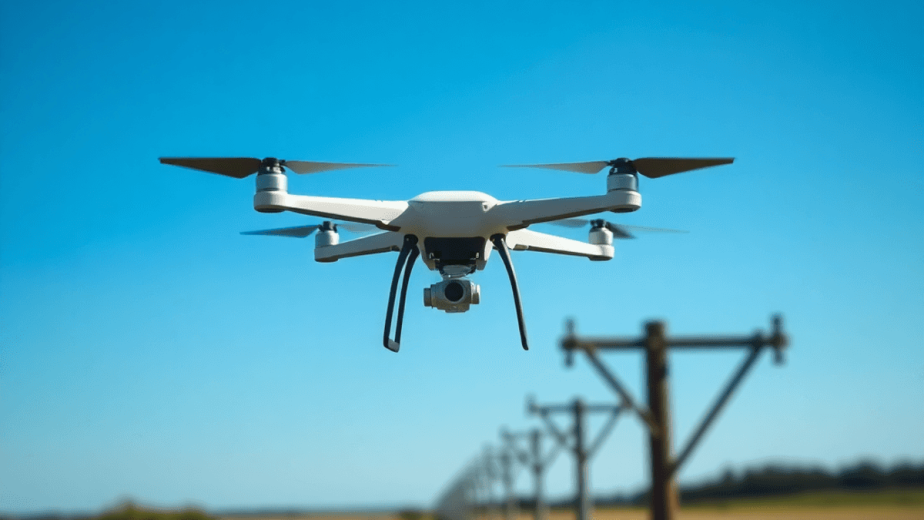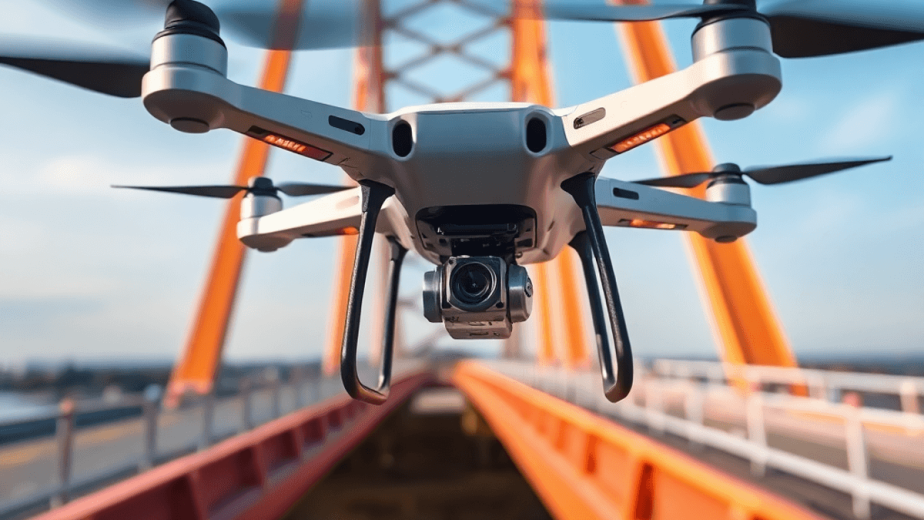Introduction
Drones have become a game-changer for construction site inspections, completely changing the way projects are overseen and controlled. Their rising popularity is due to their ability to provide wide-ranging aerial views and data collection capabilities that traditional methods can’t compete with.
The top benefits of inspecting construction sites with drones include:
- Improved safety for workers by reducing exposure to dangerous areas
- Cost efficiency through significant savings on labor and time
- Enhanced data collection with high-resolution images
- Real-time monitoring for flexible project management
- Increased accuracy in surveys and measurements
- Frequent inspections that allow early issue detection
- Streamlined communication among stakeholders
- Environmental impact reduction by minimizing heavy equipment usage
Mira Spatial stands out as a leading company in this field, offering innovative solutions that leverage drone technology to enhance infrastructure monitoring and analytics.
1. Improved Safety
Worker safety on construction sites is a top priority. Drones offer significant advantages in reducing risks associated with inspections in dangerous areas. These unmanned aerial vehicles (UAVs) can safely access:
- Hard-to-reach locations: Roofs, tall structures, and confined spaces can be inspected without putting workers at risk.
- Dangerous environments: Areas with structural instability or potential hazards can be monitored from a distance, reducing the likelihood of accidents.
The use of drones also leads to a significant decrease in the need for scaffolding and ladders. Traditional inspection methods often require extensive setup, increasing the chance of falls or injuries. By using drones for inspections, construction teams can:
- Conduct assessments efficiently
- Ensure compliance with safety regulations
- Focus on proactive risk management
Incorporating drone technology not only improves worker safety but also promotes a culture of responsibility and care within the industry.
2. Cost Efficiency
Integrating drones into construction site inspections can lead to significant cost savings. Here are the main reasons why:
1. Lower Operational Costs
Traditional inspection methods often involve extensive labor and equipment expenses. Drones streamline these processes, resulting in lower operational costs.
2. Savings Statistics
Research indicates that using drones can reduce inspection costs by as much as 30%. This reduction comes from needing less manpower and using less equipment.
3. Impact on Budgets and Timelines
Drone technology speeds up the inspection process, allowing for quicker project completion times. Faster inspections lead to more accurate budgeting, which means better use of resources throughout the project.
Investing in drones not only improves safety but also offers a way to save money in construction projects. As the industry embraces this new technology, there is a great opportunity to reduce costs while still maintaining quality.
3. Enhanced Data Collection
Drones have completely transformed the way data is collected during construction site inspections, offering significant benefits over traditional surveys conducted on the ground.
1. Quality and Precision
Drones provide high-quality aerial imagery that captures detailed site conditions. This level of precision is essential for accurate project monitoring and assessment.
2. High-Resolution Imagery
The importance of high-resolution imagery cannot be overstated. It allows project managers to evaluate progress with clarity, identify potential issues early, and ensure compliance with design specifications.
Data accuracy significantly improves when using drone surveys, making them an invaluable tool in construction management. Inspecting construction sites with drones not only enhances the quality of data but also supports informed decision-making throughout the project lifecycle. The integration of advanced technologies like those offered by Mira Spatial further amplifies these benefits, streamlining processes and enhancing analytical capabilities.
4. Real-Time Monitoring
The integration of drone technology into construction site inspections has transformed the way real-time monitoring is done.
Benefits of Real-Time Monitoring with Drones
- Instant assessment: Drones provide immediate access to critical site information, enabling project managers to make data-driven decisions swiftly.
- Problem-solving capabilities: Real-time data access allows teams to identify issues as they arise, facilitating quicker resolutions and minimizing potential delays.
This proactive approach enhances construction management by ensuring that any discrepancies or challenges are addressed promptly. Regular aerial surveys keep all stakeholders informed about project progress and site conditions, fostering transparent communication. By leveraging real-time insights, construction teams can maintain project timelines and budgets more effectively, ultimately leading to successful project outcomes. The shift towards using drones for continuous monitoring underscores the importance of agility in managing complex construction environments.
5. Increased Accuracy
Drones have transformed measurement techniques in construction, resulting in significant improvements in survey accuracy. The use of UAV technology offers several advantages:
- High-Precision Data Collection: Drones capture detailed images and data at resolutions previously unattainable with traditional surveying methods.
- Consistency in Measurements: Automated flight paths ensure that measurements are taken from the same angles and positions, reducing human error.
- 3D Mapping Capabilities: Advanced sensors enable the creation of accurate 3D maps, which are essential for visualizing complex project sites.
These improvements in measurement precision directly contribute to successful project execution. Accurate surveys provide a solid foundation for design and planning, minimizing costly mistakes and ensuring that projects stay on schedule. With drones, construction professionals access reliable data that supports better decision-making throughout the project lifecycle.
6. Frequent Inspections
Regular check-ups on construction sites using drones provide numerous advantages throughout a project’s lifecycle. Drones make it possible to inspect sites frequently, which helps identify problems early on and greatly reduces the chances of expensive delays or rework.
Key benefits include:
- Timely Identification: UAV technology allows for the rapid identification of potential problems, from structural flaws to site safety hazards.
- Proactive Management: By addressing issues as they arise, teams can implement corrective actions before they escalate into larger complications.
- Increased Productivity: Frequent inspections streamline workflows and help maintain project schedules by ensuring that everything runs smoothly.
Using drones for regular inspections not only improves supervision but also encourages ongoing improvement in construction practices. This technology’s integration into routine checks changes how construction sites are observed, making it simpler to uphold high quality and safety standards.
7. Streamlined Communication
Effective communication among project stakeholders is crucial for the success of any construction project. Drones play a significant role in enhancing this communication through the use of aerial visuals.
1. Visual Data Sharing
Aerial imagery captured by UAVs provides clear, real-time visual data that can be shared easily among teams. This facilitates better team collaboration by ensuring everyone is on the same page regarding project status and progress.
2. Project Updates
Shared drone imagery allows for immediate updates on any potential concerns or changes in the construction process. Stakeholders can visualize developments without the need for lengthy reports or meetings, saving time and reducing misunderstandings.
The integration of drone technology not only keeps all parties informed but also fosters transparency and accountability throughout the project lifecycle. The result is a more cohesive effort towards achieving project goals efficiently and effectively.
8. Environmental Impact
The adoption of drone technology in construction site inspections promotes sustainable practices through eco-friendly methods. Key benefits include:
- Reduction in Heavy Equipment Usage: Traditional inspections often require heavy machinery, which contributes significantly to carbon emissions. Drones eliminate this need, allowing for smaller, less impactful operations.
- Lower Carbon Emissions: By minimizing the reliance on vehicles and equipment for inspections, drones help reduce the overall carbon footprint of construction activities.
- Minimized Disturbance to Ecosystems: UAVs can operate with minimal physical disruption to the surrounding environment. This is crucial for preserving local wildlife habitats and maintaining ecological balance.
Utilizing drones not only enhances efficiency but also aligns with environmental stewardship goals in the construction industry. The shift towards aerial inspections signifies a commitment to reducing the ecological impact while promoting innovation in project management.
The Future of Construction Site Inspections: Embracing Drone Technology and Innovative Solutions from Mira Spatial
The world of construction site inspections is changing quickly, thanks to improvements in drone technology. Companies like Mira Spatial are leading this change, providing creative solutions that make aerial inspections better.
Future Advancements in Drone Technology
Here are some expected advancements in drone technology that will impact construction site inspections:
- Integration of AI and Machine Learning: Expect drones to incorporate advanced algorithms for real-time data analysis, improving decision-making processes.
- Enhanced Imaging Technologies: Innovations in thermal and multispectral imaging will provide deeper insights into structural integrity and environmental conditions.
- Automated Flight Planning: Automation will streamline inspection processes, allowing for more frequent site evaluations without manual intervention.
Top Benefits of Inspecting Construction Sites with Drones
Here are some key benefits of using drones for inspecting construction sites:
- Cost Efficiency: Reduced labor costs and time savings will continue to make drone inspections a financially viable option.
- Improved Safety: As technology advances, the ability to conduct inspections from safe distances will further minimize risks to workers.
- Accurate Data Collection: Future drones will deliver even higher resolution data, facilitating better project planning and execution.
Mira Spatial’s commitment to innovation ensures that the future of construction site inspections is not only efficient but also sustainable. Embracing these advancements positions companies for success in an increasingly competitive industry.



